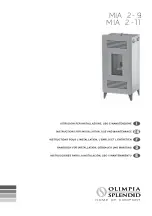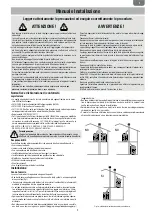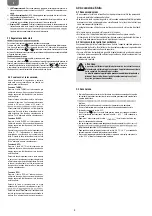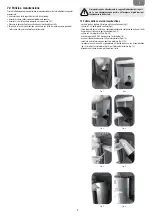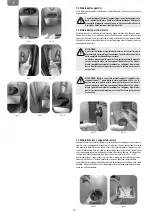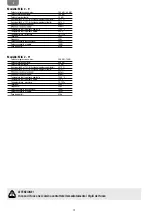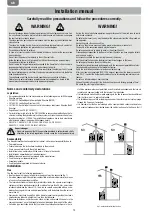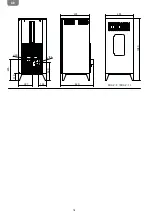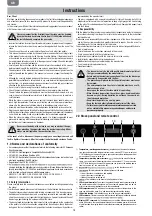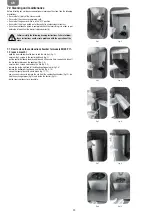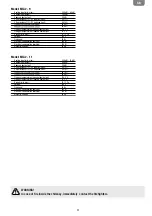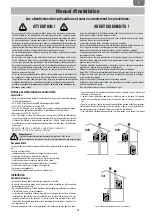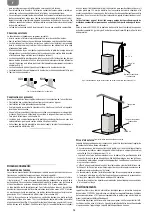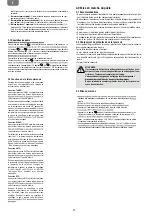
15
GB
is easily opened and inspected through the air-tight door.
• Whenever flues with parallel exits are used it is advisable to raise the upwind chamber
by one element.
• The chimney tube must never pass across a combustible surface.
The Chimney Cap
The chimney cap must respect the following requirements:
• It must have the equivalent diameter and internal form of the flue.
• It must have a useful outlet diameter of not less than double that of the flue.
• The chimney cap on the roof or that remains in contact with the outside (for example,
in case of open lofts or attics), must be covered with elements in brick or tile and
must, in any case, be well insulated.
• It must be constructed to prevent rain, snow, and extraneous bodies from entering the
flue and so that the discharge of the products of combustion is not inhibited by wind
from any quarter or strength (windproof chimney cap).
• The chimney cap must be positioned in such a way as to guarantee the adequate di-
spersion and dilution of the products of combustion and in any case, must be out of
the reflux zone. This zone has different dimensions and forms according to the angle
of inclination of the roof so it is necessary to adopt minimum heights (Fig. 2).
• The chimney cap must be a wind-proof type and must be above the ridge.
• Eventual structures or other obstacles that are higher than the chimney cap must not
be too close to the chimney cap itself.
Canalisation (if available)
Before you connect the auxiliary pipes for the canalisation of the air, please check that:
• The canalisation system is according to law.
• The system does not present any obstructions.
• Once you connect the stove and use the air ducting, there is a regular air flow at the
end of the canalisation.
• You can use up to two hot air delivery pipes with a maximum lenght of 4 m. each. If
you use only one pipe, the maximum lenght is 5 m. For more information see chapter
6.0.
• The piping and conduit must be protected with fixed, non-reclosable grids or suitable
covers. The minimal section must not be reduced anyway.
Sizing
Smoke discharge
The discharge system must be for the stove only (it is not permissible to discharge into
flues in common with other devices). The smoke discharge takes place through the 8
cm diameter tube placed at the back. A “T” with a condensation collection cap should
be provided. The smoke discharge of the stove must be connected with the outside
using a steel or black tube (resistant up to 450°C) without obstructions.
The tube must be hermetically sealed. To make the tubes airtight and for their eventual
insulation, it is necessary to use material resistant up to at least 300°C (silicone or putty
for high temperatures). The horizontal sections can be up to 2 m long. It is possible to
have up to three 90° curves.
If the smoke duct is outside it must be insulated (Fig.4).
If the smoke duct is inserted in a flue (Fig.3), this must be certified for solid combustibles
and if it is larger than 150 mm in diameter, modification is necessary by inserting a tube
and sealing the discharge with respect to the parts in brickwork.
It must be possible to inspect all the sections of the smoke duct. If it is a fixed duct it
must have openings for inspection and cleaning.
The adjacent locale must not be used as a garage or be a space without ventilation
or air exchange, a storage area for combustible material or used for an activity
that has a fire hazard.
According to the norm UNI 10683/98, the stove must not be in
the same environment where extractors, type B gas devices or in any case, devices that
create lower atmospheric pressure in the locale are found.
External air intake
The stove must be furnished with the air necessary to guarantee the regular functioning
of the combustion and an environmental well being.
• Be sure that the room where the stove is installed has sufficient aeration and, if ne-
cessary, install an air intake duct with a minimum recommended diameter of 50 mm
and max length 1,5 m to bring in air from the outside.
• The external air intake must communicate with the stove and positioned so that it is
not obstructed. It must be protected with a permanent non-closable grill or other sui-
table protection provided that the minimum diameter is not reduced.
• The air flow can also be acquired from a locale adjacent to where the stove is installed
as long as that flow can freely cross the permanent non-closable openings that com-
municate with the outside.
• The presence in the local adjacent to where the stove is installed, of other devices in
use or of suction devices that cause a contrary draught effect must not create a lower
air pressure in the locale than in the outside environment.
• In the adjacent locale the permanent openings must respond to the requisites which
are listed in the points above.
Positioning
The stove is furnished with an electrical cable to connect to a 230V 50Hz socket, pre-
ferably with a thermal-magnetic switch. Variations in tension of more than 10% can
compromise the stove (if not already present, an adequate differential switch should be
provided). The electrical system must comply with the norms; verify in particular the ef-
ficiency of the ground circuit. The electrical feed cable must be of a diameter adequate
to the power of the device. The stove must be completely level. Verify the weight bearing
capacity of the flooring.
The placement of the stove within the living environment is determined so that the en-
vironment is heated in a uniform manner.
Before deciding where to place the stove, keep in mind that:
• The air used for combustion must not come from a garage or a space without venti-
lation or air exchange, but from a free space or the outside;
• The stove should not be installed in a bedroom;
• Rather it is preferable to install the stove in a large, central room of the house to insure
the maximum heat circulation;sicurare la massima circolazione del calore;
Fig.2: characteristics of the chimney cap
NO
SI
Fig.3: internal flue installation to do according to norms
Air intake
min. 1,5 m
Condensation collection cap
Air intake
Condensation collection cap
Presa d’aria
Insulated tubing
Содержание MIA 2-11
Страница 1: ...MIA 2 9 MIA 2 11...
Страница 2: ......
Страница 5: ...5 I MIA 2 9 MIA 2 11 475 1050 520 227 133 390 340 50 80 110 455...
Страница 13: ...13 I...
Страница 16: ...16 GB MIA 2 9 MIA 2 11 475 1050 520 227 133 390 340 50 80 110 455...
Страница 24: ...24 GB...
Страница 27: ...27 F MIA 2 9 MIA 2 11 475 1050 520 227 133 390 340 50 80 110 455...
Страница 35: ...35 F...
Страница 38: ...38 D MIA 2 9 MIA 2 11 475 1050 520 227 133 390 340 50 80 110 455...
Страница 46: ...46 D...
Страница 49: ...49 E MIA 2 9 MIA 2 11 475 1050 520 227 133 390 340 50 80 110 455...
Страница 57: ...57 E...
Страница 58: ......
Страница 59: ......
Страница 60: ...278960A...

